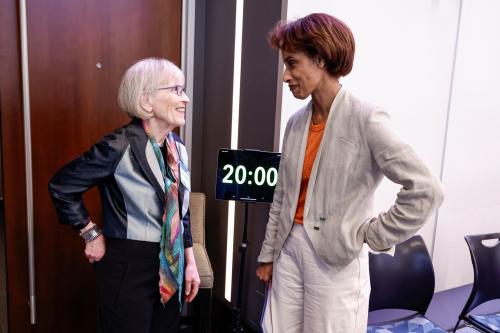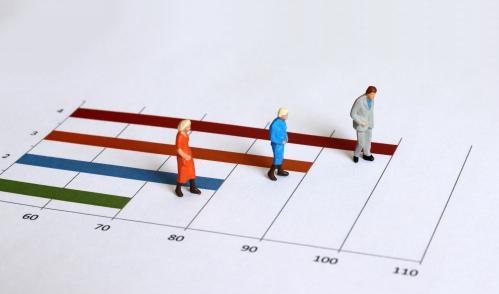Aging is often mentioned as one of the most important challenges faced by societies in the industrialized world. On the one hand, an aging workforce is seen as a burden for economic growth and the sustainability of public finances. Estimates of the effect of population aging on economic growth for the U.S. by researchers at Harvard Medical School and the RAND corporation suggest that a 10 percent increase in the share of population aged 60 or more decreases the growth rate of GDP per capita by approximately 5.5 percent. On the other hand, aging societies are often blamed for political and social phenomena such as the rise of populism and the appearance of seemingly unsurmountable obstacles to further European integration.
The empirical evidence supporting the existence of a global aging trend that is particularly advanced in developed economies appears unquestionable. The population projections by the World Population Prospects: The 2019 Revision indicate that currently around 9 percent of the world population is above 65 years of age, a number expected to increase to 16 percent by 2050. In Europe, such a demographic projection exercise leads to 28 percent of the population being above 65 years of age in 2050, up from 19 percent in 2020. The median age of Europeans, currently 42.5 years, is projected to increase to over 47 years.
The categorization of the population aged above some threshold (usually 65 or 70) as belonging to the “old age” group and the construction of statistics based on ratios of this subset of the population to other age groups has a long history in demography. Back in 1913, Carl Ballod proposed the use of “coefficients of burden” that measured the ratio of infants (aged 0 to 14) and elderly (70 and above) to the rest of the population as dependency ratios. Whether the threshold used to define old age is set to 65, 70, or any other chronological age, the choice is arbitrary and poses problems for measuring the aging of populations over time.
65 is already the new 54
These thresholds appear especially arbitrary when one considers the improvements in life expectancy that have taken place during the last few decades; older age groups nowadays live much healthier and longer lives than those of earlier generations. A 65–year-old woman in South Korea in 1970, for instance, had a remaining life expectancy of 14.9 years, while this figure in 2018 is 22.8 years. This remaining life expectancy would have corresponded to that of a 54–year-old South Korean woman in 1970, suggesting that 65 is actually the new 54! Comparing the shares of persons of a given chronological age over time as in standard demographic analysis based on (chronological) aging indicators can therefore be extremely misleading. With increasing life expectancy, ratios based on subpopulations exceeding a certain fixed age are doomed to send signals that systematically overestimate the potential burden of aging populations.
During the last years, fueled mostly by the research of Sergei Scherbov and Warren C. Sanderson, a series of novel measures of aging which build upon the concept of prospective longevity have been developed. The main idea behind this new approach of measuring aging populations is to move from the comparison of persons with the same chronological age (that is, age since birth) to those with the same prospective age (that is, age based on remaining life expectancy). The image of population aging resulting from tracking prospective measures over time differs substantially from that obtained by tracking variables based on chronological age.
As an example, Figure 1 shows the development of the share of female population aged 65 and above in South Korea for the period 1970-2020, as well as projections for 2030, together with that of the share of women with remaining life expectancy below 15 years—a threshold chosen so that the corresponding ratios are roughly similar in 1970. The dynamics of the chronological aging measure in Figure 1 are routinely used as empirical evidence to frame the policy discussion on present and future demographic dynamics as a global challenge to economic prosperity. But the picture painted by the change in the share of women with low life expectancy is radically different: this indicator decreased until the beginning of the 21st century and has only recently exceeded the value it had in 1970. By the end of the 20th century, South Korean women got “prospectively” younger as they became chronologically older. In addition, the expected increases in life expectancy for the coming years lead to basically no change in the prospective aging measure until 2030, compared to a projected increase in the chronological aging measure which would be the largest experienced so far.
Figure 1. Comparing share of women aged 65 and above and share of women with remaining life expectancy below 15 years, South Korea 1970-2030
 Source: Wittgenstein Centre Human Capital Data Explorer
Source: Wittgenstein Centre Human Capital Data Explorer
Prospective aging
To the extent that changes in prospective indicators of aging integrate the joint dynamics of health and age structure, they contain more valuable information about current and future macroeconomic developments than standard aging measures based exclusively on chronological age. In particular, prospective aging measures have been found to be better predictors of GDP per capita changes than their counterparts which use chronological age.
There are obvious advantages of this new approach to the measurement of aging at the aggregate level. Obtaining a reliable picture of demographic change in modern societies, which allows for comparability across time and between countries, requires the incorporation of prospective aging variables into the portfolio of standard measurements that inform evidence-based policymaking. Looked at this way, the world’s economic future is not quite as grey as conventional aging statistics might have us believe.






Commentary
Rethinking aging societies: Growing young as you get old
October 26, 2020